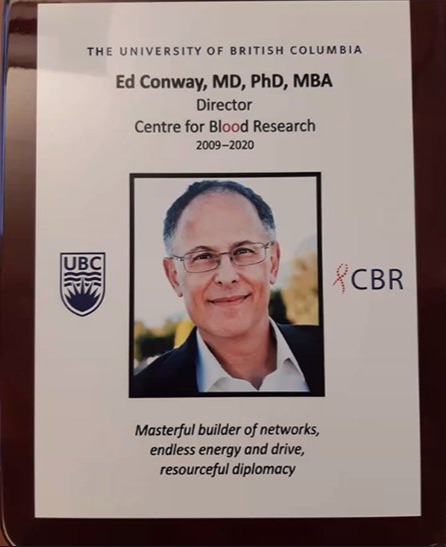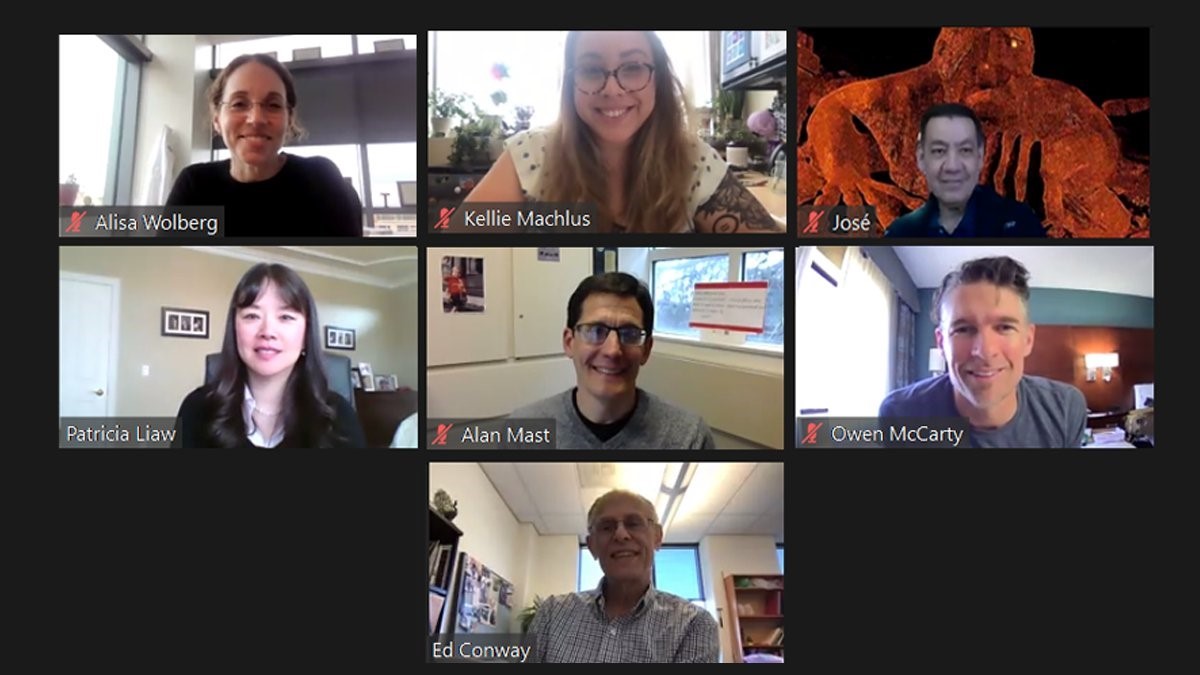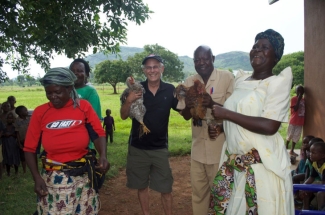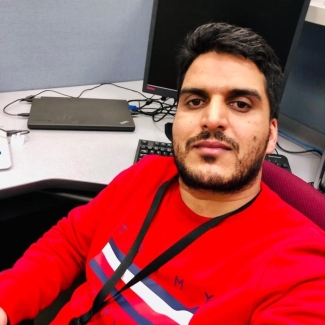Honouring Dr. Ed Conway: A symposium on blood and blood-related disorders
Thursday, August 12, 2021 Marie-Soleil Smith
This post was originally published on July 22, 2021, on the Centre for Blood Research blog. Dr. Ed Conway is a Canadian Blood Services’ adjunct scientist. Canadian Blood Services and the Centre for Innovation are proud to partner with the Centre for Blood Research to deliver training and education events.
At the end of 2020, Dr. Ed Conway’s tenure as director of the Centre for Blood Research (CBR) concluded after 11 dedicated years. His directorship was characterized by boundless energy and enthusiasm, and under his leadership, the CBR has grown and flourished. To honour Dr. Conway and his achievements, a virtual CBR Symposium was held on April 15th, 2021. The symposium started off with Dr. Dana Devine, Dr. Conway’s successor and the current director (and Canadian Blood Services’ chief scientist), expressing gratitude for the 11 years that Dr. Conway served as a phenomenal director of the CBR, emphasizing his immense contributions to the Centre and the greater scientific community.

The symposium consisted of six talks presented by researchers from Canada and the United States, encompassing a wide range of blood-related topics including clotting and sepsis, touching on Dr. Conway’s areas of expertise. Dr. Alisa Wolberg of the University of North Carolina Blood Research Center commenced the day’s talks. She remarked that the dysregulation of pathways involved in the prevention or formation of blood clots may play a role in disordered physiological changes involved in obesity. A key point she brought up was to always consider what is happening in the organism as a whole, as just modifying a single protein of interest that shows up as a hit in one’s proteomics may not address the whole story. Up next was Dr. Kellie Machlus of Harvard Medical School, a previous student of Dr. Wolberg, who spoke about her research on platelets. She described how her lab aims to understand the regulation of platelet production from their precursor cells, megakaryocytes, and how inflammation is involved in this process.
After a quick break, Dr. Owen McCarty from the Oregon Health & Science University commenced the second set of talks. He incorporated Indigenous ways of knowing into his talk by highlighting the Raven, a transformative hero as well as a sinister trickster, held dearly by the Haida people. He drew parallels between Factor XIa, an important blood clotting factor, and the trickster Raven, as Factor XIa is implicated in disease, despite its necessity to survival, and proposed potentially “clipping the wings” of Factor XIa to safely treat related pathologies. Following Dr. McCarty was Dr. Patricia Liaw of McMaster University who conducted one of the largest pan-Canadian translational studies of ICU patients to create a personalized tool for assessing mortality risks in patients with sepsis. Using her newly developed tool, Dr. Liaw identified biomarkers that distinguish COVID-19 ICU patients from non-COVID-19 ICU septic pneumonia patients and finished her talk with a message on the importance of considering biological sex in research.
The third and final set of talks was presented by Dr. José López of the University of Washington School of Medicine and Dr. Alan Mast of the Medical College of Wisconsin. Dr. López identified an overlap of pathways that could exacerbate the narrowing of the aorta due to accumulation of plaque through interactions with von Willebrand factor (VWF), an important protein involved in stopping a bleed. Dr. Mast delivered the final talk on an anti-coagulant protein, tissue factor pathway inhibitor (TFPI), and its physiologically relevant roles in insect bites, bleeding disorders and clotting disorders. He also pinpointed a critical role of TPFI as a modulator of thrombin production that significantly alters cerebrovascular development.

A common theme throughout the talks was the importance of acknowledging how truly complicated the human body is, and that the overlap of pathways must be considered to understand the whole picture. From Dr. Wolberg’s talk that highlighted the importance of biochemistry in the whole organism to Dr. López’s talk about the role that various interactions of VWF play in vessel narrowing, we heard exemplary examples of the necessity of applying a broader view to our own research.
All speakers expressed a personal moment shared with Dr. Conway, and the impact he has had on them and their research. From interacting at meetings to more in-depth collaborations, Dr. Conway has been a fantastic leader and an exquisite example of a “curious scientist” with his thought-provoking insights and highly educated questions at every single talk. His dedication to conducting clinically relevant research, creating trainee opportunities, and leading the CBR to international recognition will be a lasting legacy. We are delighted and grateful that Dr. Conway will continue to be an integral member of CBR even after stepping down from his director role.
The guest of honour wrapped up the symposium with a few final words. Dr. Conway highlighted that the current state of the CBR, of which we can be so proud, is a testament to those who created the Centre and to all who have contributed towards its significant scientific growth. The CBR is special because of the thriving community that has been built among its members. To echo Dr. Conway’s closing remarks, I would like to extend many thanks to the esteemed speakers, the devoted organizers from the CBR Admin Team, and of course the attendees who contributed towards making this symposium an event of importance.

Canadian Blood Services – Driving world-class innovation
Through discovery, development and applied research, Canadian Blood Services drives world-class innovation in blood transfusion, cellular therapy and transplantation—bringing clarity and insight to an increasingly complex healthcare future. Our dedicated research team and extended network of partners engage in exploratory and applied research to create new knowledge, inform and enhance best practices, contribute to the development of new services and technologies, and build capacity through training and collaboration. Find out more about our research impact.
The opinions reflected in this post are those of the author and do not necessarily reflect the opinions of Canadian Blood Services nor do they reflect the views of Health Canada or any other funding agency.
Related blog posts
This week, we catch up with Dr. Ed Conway, the director of the Centre for Blood Research at the University of British Columbia and a Canadian Blood Services adjunct scientist.
Postdoctoral fellow, Dr. Basit Yousuf, describes his experience attending and presenting at the 10th annual Norman Bethune Symposium.
The AABB Annual Meeting is considered a must-attend event for those wishing to learn about cutting edge research and technology advances in blood banking and transfusion medicine and science. Two Centre for Blood Research trainees describe their experiences at AABB 2020 – an international, high profile conference attended from the comfort of their own homes due to COVID-19 restrictions.


